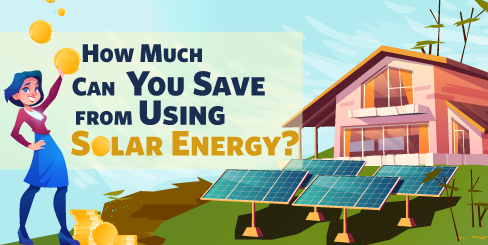Solar power technology has drastically improved over the years, becoming a more efficient energy source while potentially lowering installation and maintenance costs. In other words, solar panels are now made more affordable, encouraging customers to switch to an eco-friendly alternative for generating power while potentially saving money on electrical bills.
That said, some people are afraid to commit, likely because it costs a bit more upfront than traditional electrical line installations. But what if you get to see an estimate or breakdown of the actual money you get to save by using solar energy?
Below is an explanation of your household’s solar energy savings if you use this as your primary energy source.

5 Factors that Affect Electrical Consumption
Before you dive deep into the nitty-gritty of your bill, you must first understand the different factors that can contribute to high or low energy spend in a household.
1. Weather
The way you use power will vary as different seasons come and go. Generally, during summer or hotter months, you will use more fans or air conditioners to keep yourself cool at home. This could even mean having them running round the clock, which could naturally impact your monthly bill.
Then, there’s the opposite side of the coin. Colder months may have you using your home’s heating systems instead—but this also means it will be left open the whole day to keep you comfortable. There are also in-between months wherein you may not use either your cooling or heating systems, meaning you get to cut back on energy consumption.
2. Number of people in the household
It’s safe to assume that a family of four will have a lower monthly energy usage than a family of seven. The more rooms you have and the more people using electricity to do different things at once, the higher your home’s power requirements.
3. Living habits
Do any of your family members work from home? How long does it usually take for you to use the shower? Is having a movie night every week a ritual in your household?
These questions pertain to the type of lifestyle you have, and they can also impact your energy consumption. The more you use power at home to do tasks, destress, and whatnot, the higher the figures that will appear in your bill, more so during these times when most of us are working from home.
4. Design of the home
How well your home is maintained can also impact the cost. For instance, if all the windows in your room are functional, it can get cool or warm faster as no air can escape or enter. If you have a single-story home, there is also less room for your appliances to heat or cool.
An older house may also have less insulation, so it can’t trap heat well. And if you have a tree above your home, chances are it provides shade and additional cooling during warm months. These factors may seem small but can add up to how you use electricity.
5. Electrical appliances
If you have many appliances that eat up a ton of power, you might be used to seeing an expensive electric bill. On the other hand, energy-saving appliances can make a difference in cutting down costs if you make sure you buy the right ones that are fit for your home.
How Much Can You Save from Using Solar Energy?
Solar panels have always been a great option when it comes to potential energy savings. However, it’s important to know that the amount you save will vary depending on several factors. Based on average stats, we can provide an approximation.
The US Energy Information Administration (EIA) estimates that an average household consumes 887 kWh and spends around US$115 (PHP5,523.28) a month. A 2-square meter solar panel can generate up to 45 kWh of AC energy per month. So, to cover completely the monthly average demand of 887 kWh per household, you need 20 panels with a total of 8kWp producing a total of 900kWh 45 output per month.
With each panel producing 400 watts an hour, this totals to 8,000 watts per hour for all 20 panels. If you think this is too much, remember that you can earn from the excess energy your system produces and exports back to the grid. Solar panels make use of the sun, a renewable energy source, so it doesn’t go to waste.
With this model, if enough solar panels are installed to cover the average electricity consumption per month, a household could save US$1,384 (PHP66,471.44) per year—or not have to pay for electricity at all.
In the Philippines, the average household consumption in 2015 was 248.1 kWh, which was primarily spent on lighting, cooking, recreation, and space cooling. Using the same model, a Philippine household would need around six (6) panels to meet the average demand. If we use the $0.20 (PHP9.61) per kWh price and today’s PHP48.03 to $1 conversion, that’s a savings of around PHP2,384 per month.
Appliances That Consume a Lot of Electricity
Certain household appliances consume a lot of energy. You can swap some for energy-saving alternatives, while being aware of how much electricity they consume may be good enough for other items. This way, you can be mindful of your usage and potentially cut down on costs.
- Refrigerator – Having a fridge at home is necessary to keep groceries and produce fresh, but it generally consumes a lot of energy since it’s turned on 24/7. The average consumption of a 16-cu. ft. fridge is 1,200-watt-hours per day. Get a size that fits your family’s needs (not too big or small) and keep it a couple of inches away from the wall for proper ventilation.
- Water Heater – Warm baths are incredibly relaxing, but if you take pleasure in having long showers, know that a water heater can consume 4,500-watt-hours per day. While it’s alright to indulge every once in a while, being mindful of your shower time could help reduce both your electric and water bills.
- Air Conditioner – While a must-have during the summer months, it’s one of the appliances that is most easily overused. The type of air conditioner, the size of the room you are keeping cool, and how long it’s running are factors contributing to a higher electrical bill. Set timers, if possible, to control your usage.
- Clothes Dryer – Clothes dryers are another useful appliance to have around, especially during rainy or colder seasons. The only downside is it clocks in about 3,000-watt-hours per day. It’s always best to use the sun’s warmth, if possible, to dry out clothes. That way, you don’t have to use it all year round.
- Incandescent Light Bulb – A room that has around four 100-watt bulbs could rake up 400-watt-hours a day—and that’s just one room. An LED bulb, in comparison, only uses 10 watts—ten times less than a traditional one. If you think this number is insignificant, think again. It’s much better to switch to these energy-saving alternatives.
- Desktop Computer – If you’re on your desktop computer for eight hours or more a day, you might want to pay attention to how much it takes up energy at home. While you might not have much control over this, especially if you work from home, remember to unplug your devices when not in use. Switch to a laptop, if possible. Not only does it consume less energy, but you also won’t need to use the outlet all the time.
Just One More Reason to Go Solar
If you have been on the fence about switching to solar energy, then maybe these numbers helped clarify things for you. You not only increase your chances of saving on electrical costs but helping the world become a greener place, too.
SolarNRG, a leading solar company in the Philippines, is here to help answer any questions you may have about switching to solar. Contact us today for a quote.


Recent Comments